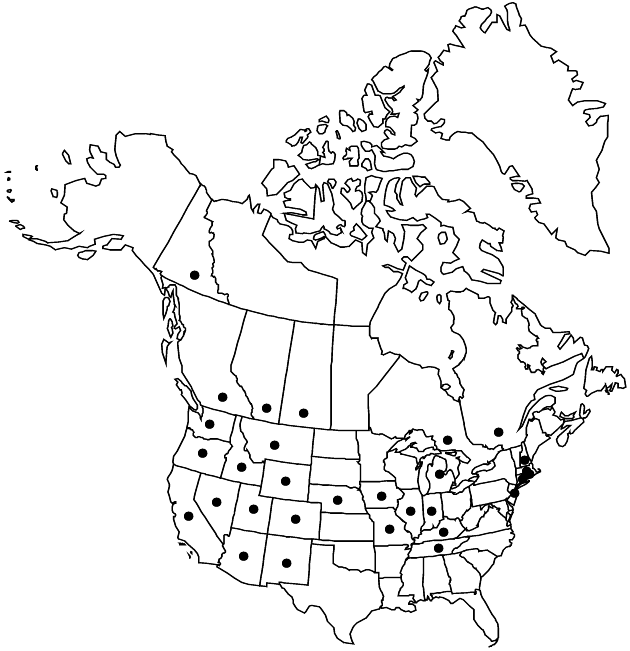Difference between revisions of "Centaurea diffusa"
in J. Lamarck et al., Encycl. 1: 675. 1785.
FNA>Volume Importer |
FNA>Volume Importer |
||
| Line 27: | Line 27: | ||
|elevation=100–2200 m | |elevation=100–2200 m | ||
|distribution=Alta.;B.C.;Ont.;Que.;Sask.;Yukon;Ariz.;Calif.;Colo.;Conn.;Idaho;Ill.;Ind.;Iowa;Ky.;Mass.;Mich.;Mo.;Mont.;Nebr.;Nev.;N.H.;N.J.;N.Mex.;Oreg.;R.I.;Tenn.;Utah;Wash.;Wyo.;Europe. | |distribution=Alta.;B.C.;Ont.;Que.;Sask.;Yukon;Ariz.;Calif.;Colo.;Conn.;Idaho;Ill.;Ind.;Iowa;Ky.;Mass.;Mich.;Mo.;Mont.;Nebr.;Nev.;N.H.;N.J.;N.Mex.;Oreg.;R.I.;Tenn.;Utah;Wash.;Wyo.;Europe. | ||
| − | |discussion=<p>Centaurea diffusa is native to southeastern Europe and casually adventive in central and western Europe.</p><!-- | + | |discussion=<p><i>Centaurea diffusa</i> is native to southeastern Europe and casually adventive in central and western Europe.</p><!-- |
| − | --><p>Centaurea diffusa readily hybridizes with C. stoebe subsp. micranthos and is often confused with their fertile hybrid (C. ×psammogena G. Gáyer); the latter can be recognized by its cypselae bearing pappi and having conspicuously radiant heads. Morphologically the hybrids are extremely variable; they may be intermediate or may closely resemble one or the other of the parents. Conspicuously radiant heads and pappi are always present; appendages of the phyllaries are brown to black, or rarely stramineous; spines are absent or short and 2n = 18. Centaurea ×psammogena is known from waste places, roadsides, railway tracks; 50–2500 m; B.C., Ont., Que.; Colo., Mass., Mich., Mo., N.C., Oreg., Tenn., Wash. It may occur spontaneously where the ranges of the parent species overlap; they may also be distributed separately. In mixed stands it replaces C. diffusa by introgression. Hybrids are often misidentified as C. diffusa.</p> | + | --><p><i>Centaurea diffusa</i> readily hybridizes with <i>C. stoebe </i>subsp.<i> micranthos</i> and is often confused with their fertile hybrid (C. ×psammogena G. Gáyer); the latter can be recognized by its cypselae bearing pappi and having conspicuously radiant heads. Morphologically the hybrids are extremely variable; they may be intermediate or may closely resemble one or the other of the parents. Conspicuously radiant heads and pappi are always present; appendages of the phyllaries are brown to black, or rarely stramineous; spines are absent or short and 2n = 18. <i>Centaurea</i> ×psammogena is known from waste places, roadsides, railway tracks; 50–2500 m; B.C., Ont., Que.; Colo., Mass., Mich., Mo., N.C., Oreg., Tenn., Wash. It may occur spontaneously where the ranges of the parent species overlap; they may also be distributed separately. In mixed stands it replaces <i>C. diffusa</i> by introgression. Hybrids are often misidentified as <i>C. diffusa</i>.</p> |
|tables= | |tables= | ||
|references= | |references= | ||
| Line 53: | Line 53: | ||
|publication year=1785 | |publication year=1785 | ||
|special status= | |special status= | ||
| − | |source xml=https://jpend@bitbucket.org/aafc-mbb/fna-data-curation.git/src/ | + | |source xml=https://jpend@bitbucket.org/aafc-mbb/fna-data-curation.git/src/8f726806613d60c220dc4493de13607dd3150896/coarse_grained_fna_xml/V19-20-21/V19_218.xml |
|tribe=Asteraceae tribe Cardueae | |tribe=Asteraceae tribe Cardueae | ||
|genus=Centaurea | |genus=Centaurea | ||
Revision as of 15:10, 18 September 2019
Annuals or perennials, 20–80 cm. Stems 1–several, much-branched throughout, puberulent and ± gray tomentose. Leaves hispidulous and ± short-tomentose; basal and proximal cauline petiolate, often absent at anthesis, blades 10–20 cm, margins bipinnately dissected into narrow lobes; mid cauline sessile, bipinnately dissected; distal much smaller, entire or pinnately lobed. Heads disciform, in open paniculiform arrays. Involucres narrowly ovoid or cylindric, 10–13 × 3–5 mm. Principal phyllaries: bodies pale green, ovate to lanceolate, glabrous or finely tomentose, with a few prominent parallel veins, margins and erect appendages fringed with slender stramineous spines, each phyllary tipped by spine 1–3 mm. Inner phyllaries lanceolate, ± acute, appendage lacerate or spine-tipped. Florets 25–35; corollas cream white (rarely pink or pale purple), those of sterile florets 12–13 mm, slender, inconspicuous, those of fertile florets 12–13 mm. Cypselae dark brown, ca. 2–3 mm; pappi 0 or less than 0.5 mm, only rudimentary. 2n = 18, 36.
Phenology: Flowering summer (Jun–Aug).
Habitat: Disturbed sites in grasslands, woodlands, open coniferous forests
Elevation: 100–2200 m
Distribution

Alta., B.C., Ont., Que., Sask., Yukon, Ariz., Calif., Colo., Conn., Idaho, Ill., Ind., Iowa, Ky., Mass., Mich., Mo., Mont., Nebr., Nev., N.H., N.J., N.Mex., Oreg., R.I., Tenn., Utah, Wash., Wyo., Europe.
Discussion
Centaurea diffusa is native to southeastern Europe and casually adventive in central and western Europe.
Centaurea diffusa readily hybridizes with C. stoebe subsp. micranthos and is often confused with their fertile hybrid (C. ×psammogena G. Gáyer); the latter can be recognized by its cypselae bearing pappi and having conspicuously radiant heads. Morphologically the hybrids are extremely variable; they may be intermediate or may closely resemble one or the other of the parents. Conspicuously radiant heads and pappi are always present; appendages of the phyllaries are brown to black, or rarely stramineous; spines are absent or short and 2n = 18. Centaurea ×psammogena is known from waste places, roadsides, railway tracks; 50–2500 m; B.C., Ont., Que.; Colo., Mass., Mich., Mo., N.C., Oreg., Tenn., Wash. It may occur spontaneously where the ranges of the parent species overlap; they may also be distributed separately. In mixed stands it replaces C. diffusa by introgression. Hybrids are often misidentified as C. diffusa.
Selected References
None.